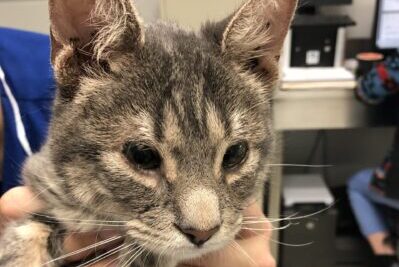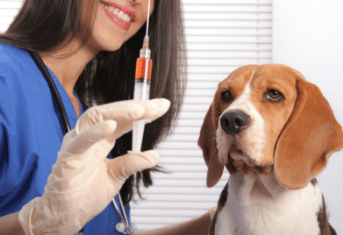Summer Safety for Pets

Summer Safety for Pets
As the weather warms up, we spend more time outdoors with our pets. Everyone is happy for the fresh air and sunshine. But are you and your pet prepared? Here are The Animal Medical Center’s suggestions for a safe summer.
All Pets Need Double ID
A loud noise, a thunderstorm or a careless barbeque guest, and your pet could escape the house or yard unnoticed. Research has shown only 20% of dogs and 2% of cats in animal shelters are reunited with their families. Make double sure your pet comes home by having your veterinarian implant a microchip and always have your pet wear a collar with an ID tag.
Open Windows Need a Screen
Every summer, the AMC’s emergency room sees cats that have fallen or jumped out of apartment windows onto the street, garden or in pursuit of a pigeon on the fire escape. So many fall, we have a name for it — high rise syndrome. Cats typically fracture their wrists, lower jaw and rupture their lungs. Most cats survive, but not all.
High rise syndrome is a completely preventable injury with a trip to your local hardware store for window screens.
Dogs are less likely to fall or jump out of an apartment building window, but will jump out of car windows. MuttManagers manufactures a customizable screen for your car’s windows. Your dog can feel the wind in his ears while you drive, but the sturdy screen keeps him safe inside. Best of all, the window still closes with the screen installed.
Don’t Let Your Pet Roam
With the pet obesity epidemic, we all want our pets to exercise more, but pets on the loose have a greater risk of automobile injuries, contracting infectious diseases, getting lost and irritating your neighbors. Tying your dog to a long lead may be disastrous, since tethered dogs left alone in a yard are more likely to bite humans. A traditional fence will confine your dog, but may not be so successful with your cat.
My patient, Harry, left, loved to chase squirrels, deer and the occasional skunk. So his family got him an Invisible Fence to keep him close to home. In this photo he is sitting in the garden, wearing his special collar which first emitted an audible warning sound, and if Harry went too far, the collar gave an unpleasant but safe electric shock to teach him to stay within the fence boundaries. It takes about 10-14 days training for a dog to learn his boundaries. Invisible Fence technology can also be used with cats, who I am pleased to say learn it faster than dogs do! Other safety applications of the Invisible Fence include teaching a pet to avoid potentially dangerous areas in the home or yard, such as a garden with toxic plants, the garage with antifreeze, swimming pools, and terraces which might result in high rise syndrome.
*****
For more great pet safety and wellness information, please join the Animal Medical Center’s Junior Committee for PAW Day 2011: Pet and Wellness Fun, a health fair for families and their pets! Sunday May 15, 2011, 9am –12 noon, featuring AMC veterinarians, information on preventative care, children’s area with Spot the dog, pet safety information, and much more! For more information or to make a contribution, please call 212.329.8660 or visit www.amcny.org.
________________________________________________________
This may also be found in the “Tales from the Pet Clinic” blog on WebMD.com.
For over a century, The Animal Medical Center has been a national leader in animal health care, known for its expertise, innovation and success in providing routine, specialty and emergency medical care for companion animals. Thanks in part to the enduring generosity of donors, The AMC is also known for its outstanding teaching, research and compassionate community funds. Please help us to continue these efforts. Send your contribution to: The Animal Medical Center, 510 East 62nd Street, New York, NY 10065. For more information, visit www.amcny.org. To make an appointment, please call 212.838.7053.


































